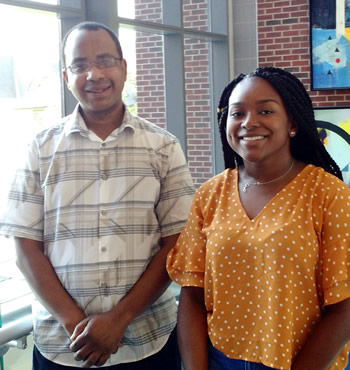By Sarah Arcos

Dr. David Mitchell is a Postdoctoral Fellow in the lab of Dr. Phil Bevilacqua in the Department of Chemistry and in collaboration with plant biologist Dr. Sally Assmann, both at Penn State University (State College, Pennsylvania, USA). After earning his B.S. in Biology from Morehouse College in Atlanta, Georgia, Dr. Mitchell began his graduate career at the University of Texas at Austin and quickly discovered an interest in RNA structure. “Graduate orientation was my first exposure to RNA structure, and I was mesmerized by talks given by Alan Lambowitz and Rick Russell.” Dr. Mitchell joined the Russell lab to examine the folding kinetics and self cleavage of the Tetrahymena group I intron ribozyme. Now as a post-doctoral researcher, funded by an NSF Plant Genome Research Project Fellowship, he continues to explore the role of RNA structure in biological processes through the development of new techniques and reagents to probe RNA structure in vivo.
Dr. Mitchell is passionate about developing new tools to advance RNA structural biology. With his post-doc mentor, he realized there were a lack of reagents able to react with uracil and guanine in vivo, representing a gap in what could be learned about RNA structure. “We decided to not leave to guessing that which we could measure,” he said. In developing new chemical probes and applying them to study RNA structure in plants in his collaboration with Dr. Assmann, he uncovered that pH influences how guanines reacts with chemicals, such as glyoxals and carbodiimide EDC. He explained, “This leads to a very interesting question of why certain guanines may be anionic in vivo, and whether they could provide any sort of previously unknown biological relevance.” For fellow researchers tackling method development, his advice is to maintain perspective on how a new method can be applied to enhance the understanding of their field (or other fields) of research.
“We decided to not leave to guessing that which we could measure”
A difficult point of Dr. Mitchell’s career came during his second year of graduate school. He reflected, “I had to abandon my original thesis project after two years of work and switch to an alternative project after learning it had a very low prospect of success despite positive early results.” Moreover, during that time, Dr. Mitchell had to add teaching assistant work because his NIH fellowship ended. To overcome this additional time burden, he continued, “I had to learn to prioritize my time very strictly and plan my work carefully.” Another key for overcoming this challenge was the great mentorship he had received throughout his training, especially his undergraduate research advisor Dr. Duane Johnson (at Morehouse College). Unsurprisingly, a major motivation in selecting the Bevilacqua lab for his postdoctoral research was its strength in mentorship, and the chance to learn plant biology from an outstanding co-mentor.
As a senior postdoc, Dr. Mitchell has himself become a mentor, guiding undergraduate and graduate students in various projects in the Bevilacqua lab. In thinking about this experience, he felt that “mentoring other trainees is now teaching me so much—albeit from a different perspective than receiving advice from my advisor. In particular, it has been a great pleasure to work with my undergraduate Glenn Duncan, and to watch her skills and personality grow tremendously.” He also emphasized the value of sharing information in the lab: “As a senior grad student or postdoc, you are an important source of information for less experienced students within the lab, so don’t be afraid to share your knowledge freely.” He continued, “This free flow of information can lead to exciting and novel ideas and unanticipated research directions.”
Dr. Mitchell doesn’t use social media, but you can reach him on LinkedIn. If you see him at an RNA Society meeting or are visiting central PA, be sure to ask him why he still has a soft spot for the Tetrahymena Group I Intron RNA.
